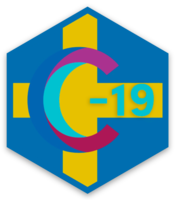

The covidsymptom R package provides an easy way to import open data from the COVID Symptom Study-Sweden. The package includes four datasets:
national_estimates - daily estimated incidence of symptomatic COVID-19 in Swedencounty_estimates - daily estimated incidence of symptomatic COVID-19 in Swedish countiespostcode_estimates - daily estimated incidence of symptomatic COVID-19 in smaller Swedish regions (2-digit postcodes)csss_tests - daily proportion of positive COVID-19 tests reported by CSSS usersInstall the CRAN version:
Development version of the package can be installed from Github with:
In order to respect CRAN best use practices, we will only push a new version of the package with most recent data every one month. However, data from COVID Symptom Study - Sweden is updated on a daily basis, thus the dev version of the package is also updated daily. The function update_csss_data() (based on a similar function from the coronavirus package), checks updates to the dataset and re-install the package with the most recent data (dev version).
If you want to avoid updating the package to have the most recent data, you can use the function get_latest_data() to import the latest version available. Notice however that this won’t re-write the package datasets.
library(covidsymptom)
national_estimates <- get_latest_data(data_level = "national")
head(national_estimates)
#> Datum Uppskattning Low_CI High_CI
#> 1 2020-05-11 0.66 0.60 0.74
#> 2 2020-05-12 0.69 0.63 0.77
#> 3 2020-05-13 0.71 0.65 0.79
#> 4 2020-05-14 0.72 0.65 0.79
#> 5 2020-05-15 0.71 0.65 0.78
#> 6 2020-05-16 0.70 0.64 0.77library(ggplot2)
library(dplyr)
covidsymptom::national_estimates %>%
ggplot(aes(x = Datum, y = Uppskattning)) +
geom_line(col = "#a60f61") +
geom_point(col = "#a60f61", size = 0.5) +
labs(x = "Date", y = "Predicted number of cases as % of the population",
title = "Predicted Number of COVID-19 Cases by Date",
subtitle = "") +
scale_y_continuous(limits = c(0, 1),
breaks = seq(0, 1, 0.2),
labels = paste0(format(seq(0, 1, 0.2), decimal.mark = ","), " %"), # add % sign to the labels
expand = c(0,0)) +
scale_x_date(date_breaks = "10 days", date_labels = "%d %b") + # can be "1 day", "2 days", etc.
theme_minimal() +
theme(axis.text.x = element_text(angle = 45, hjust = 1), panel.grid.minor.x = element_blank()) +
geom_ribbon(aes(ymin = Low_CI, ymax = High_CI), fill = "#a60f61", alpha = 0.09)
library(ggplot2)
library(dplyr)
library(lubridate)
counties_selection <- c("Skane", "Stockholm", "Vastra Gotaland", "Uppsala")
covidsymptom::county_estimates %>%
filter(Lan %in% counties_selection) %>%
ggplot(aes(x = Datum, y = Uppskattning, color = Lan)) +
geom_line() +
geom_point(size = 0.5) +
labs(x = "Datum", y = "Uppskattad förekomst", title = "% Uppskattad förekomst av symtomatisk covid-19", subtitle = "") +
scale_x_date(date_breaks = "30 days") +
theme_minimal() +
theme(axis.text.x = element_text(angle = 45, hjust = 1), panel.grid.minor.x = element_blank(),
legend.position = "none", plot.title = element_text(hjust = 0.5)) +
geom_ribbon(aes(ymin = Low_CI, ymax = High_CI), color = "transparent", fill = "#a60f61", alpha = 0.09) +
facet_wrap(. ~ Lan) 
COVID Symptom Study - Sweden provides also predictions at 2-digit postcode levels.
library(ggplot2)
library(dplyr)
library(lubridate)
library(gt)
stockholm_codes <- c('11', '12', '13', '14', '15', '16', '17', '18', '19', '76')
filtered_data <- covidsymptom::postcode_estimates %>%
filter(Postnummer %in% stockholm_codes & Datum == as.Date("2021-01-31") & !is.na(Uppskattning))
min_pred <- min(filtered_data$Uppskattning)
max_pred <- max(filtered_data$Uppskattning)
pred_palette <- scales::col_numeric(c("#f9dee2", "#5E0B21"), domain = c(min_pred, max_pred), alpha = 0.75)
filtered_data %>%
arrange(desc(Uppskattning)) %>%
gt(.) %>%
tab_header(
title = md("**Predicted number of cases as % of the population**"),
subtitle = "Stockholm's 2-digit regions"
) %>%
cols_width(starts_with("Datum") ~ px(95)) %>%
tab_style(
locations = cells_column_labels(columns = everything()),
style = list(
cell_borders(sides = "bottom", weight = px(3)),
cell_text(weight = "bold")
)) %>%
cols_align("center") %>%
data_color(columns = vars(Uppskattning),
colors = pred_palette) %>%
tab_source_note(source_note = "Data: COVID Symptom Study Sweden") %>%
tab_options(
column_labels.border.top.width = px(3),
data_row.padding = px(3),
source_notes.font.size = 12,
table.font.size = 12,
heading.align = "center",
row_group.background.color = "grey")stockholm_codes <- c('11', '12', '13', '14', '15', '16', '17', '18', '19')
covidsymptom::postcode_estimates %>%
filter(Postnummer %in% stockholm_codes) %>%
ggplot(aes(x = Datum, y = Uppskattning, color = Postnummer)) +
geom_line() +
geom_point(size = 0.5) +
labs(x = "Datum", y = "Uppskattad förekomst", title = "% Uppskattad förekomst av symtomatisk covid-19", subtitle = "") +
scale_x_date(date_breaks = "60 days") +
theme_minimal() +
theme(axis.text.x = element_text(angle = 45, hjust = 1), panel.grid.minor.x = element_blank(),
legend.position = "none", plot.title = element_text(hjust = 0.5)) +
geom_ribbon(aes(ymin = Low_CI, ymax = High_CI), color = "transparent", fill = "#a60f61", alpha = 0.09) +
facet_wrap(. ~ Postnummer, scales= "free") 
A supporting dashboard is available here

The COVID Symptom Study is a non-commercial project that uses a free smartphone app to facilitate real-time data collection of symptoms, exposures, and risk factors related to COVID-19. The app was developed by researchers at King’s College and Guys and St Thomas’ Hospitals in London in partnership with health science company Zoe Global Ltd. Baseline data and recurring daily questions are described in Drew et al (Science, 2020). The app was launched in the UK and US March 2020. In Sweden, the study is based at Lund University and, as per a collaboration agreement on 28 July 2020, Uppsala University. The app was launched in Sweden on April 29, 2020 as part of a national research initiative on COVID-19. To date, >4.5 million participants in the three countries are using the app, ~202,000 of whom live in Sweden. Participants have so far made ~271 million data entries, with Swedish participants contributing ~11 million of these.